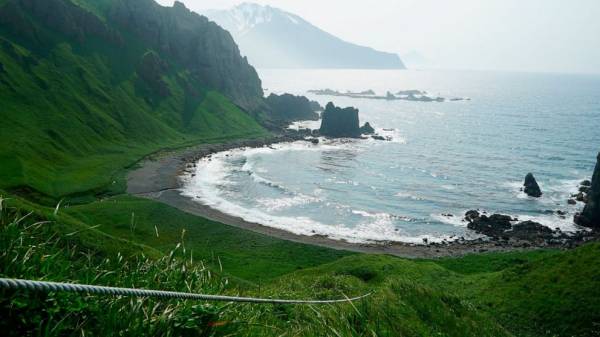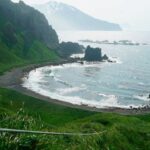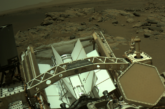
ADAK, Alaska — The roar of our rusty pickup truck rumbling down a dirt road on Alaska’s Adak Island is the only sound for miles besides the constant howling wind.
Classic rock plays on the only radio station in this remote destination on the Aleutian chain, about halfway between Seattle and Tokyo. Purple lupine line the road through grassy tundra, with snowcapped mountains and the smoking Great Sitkin volcano in the distance.
On this rare sunny day, Adak’s lush landscape looks like a sweeping movie scene. But our destination, a Cold War-era navigation facility on the northeast tip of the island, feels more like something out of a zombie apocalypse flick.
Like many other historical sites on Adak, the old LORAN (long range navigation) station is graffitied and rotting, its doors broken and ajar for easy access. Inside, it’s spooky. We timidly wander through dark, damp rooms with peeling paint and rusting generators.
Through broken windows, there are glimpses of the blue-black Bering Sea crashing into nearby Horseshoe Bay. This is the Adak experience: equal parts haunting historical relics and breathtaking natural beauty.
Home to the native Aleut people, Adak became a U.S. Army airbase during WWII to fend off a feared Japanese invasion of Alaska. The base was later transferred to the Navy and, due to its proximity to Russia, remained a strategic base and submarine surveillance center throughout the Cold War.
Now, intrepid visitors fly about four hours from Anchorage on an Alaska Airlines 737 to hunt, birdwatch, hike, or play archeologist at the dozens of defunct military sites.
Cellphone flashlights in hand, we cautiously toured abandoned residences, musty barracks, mess halls, a control tower, a school and theater, and what was once the westernmost McDonald’s — all eerily frozen in time from when the Navy left in 1997.
In town, fewer than 100 full-time residents occupy former military houses sprinkled throughout mostly vacant developments with crumbling walls and boarded-up windows.
Why do they stay? Some love the quiet isolation. Others cited the pandemic-safe locale, bonus pay for remote work, or an opportunity to do a little bit of everything. The town barkeep also works at the airport for the twice-a-week, federally subsidized flights; the restaurant cook cleans the handful of rental units by day.
Adak’s resilient locals work with what they’ve got. The only grocery store is in the old daycare center, open just a few hours on some evenings – though none during our visit. The former high school and middle school houses city hall, a health clinic and the post office.
A gas station-turned-pricy liquor store will sell you a case of beer for $50. The occasionally open eatery serves a large pizza for $28 that was surprisingly delicious given how far its ingredients had traveled.
But the real reason to visit Adak lies outside of its semi-ghost town.
Most tourists come to hunt caribou, introduced in the ’50s as a potential emergency food source in the Alaska Maritime National Wildlife Refuge on the southern part of the island.
There are also countless scenic hikes, including Finger Bay with its volcano views, and Lake Bonnie Rose, where you can tour nearby bunkers built into hills. Daring climbers use the rope mounted above picturesque Horseshoe Bay to descend to the shore and nearby hot springs below.
Clam Lagoon is teeming with sea otters, harbor seals and sea lions; its sprawling mudflats are a birder’s paradise. Adak’s bizarre “national forest,” a tiny cluster of evergreens in an otherwise nearly treeless terrain, is also worth a visit.
PLAN YOUR ADVENTURE
—Before you go: Visit Alaska’s COVID-19 information site for the latest pandemic information and travel restrictions.
—Where to stay: There are a few no-frills accommodations in old military housing ($150 night), including the Adak/Aleutian Experience and Adak Lodge and Outfitters, which offer hunting trips. Both also rent trucks for $150-$200 a day — a must-have for backcountry exploration.
—Food: Dining and grocery options are limited and often closed. Bring a cooler of food as one of your three allowed checked bags to fuel your expedition.
—Wi-Fi: With limited cell service and achingly slow satellite-based Wi-Fi, take this opportunity to truly unplug.
—Permits: You’ll need a land use permit from the Aleut Corporation to hunt or hike on Adak. Pick one up for $30 when you arrive at the airport.
—Getting around: Grab an Adak map at the airport and download offline maps before you go. The Adak historical guide is also a great resource. Avoid the well-signed landfill sites and area to the north, known as Parcel 4, due to unexploded ordnance.
Drive carefully. As our host liked to remind us, “On Adak, not all roads are roads.”
Comments (0)Share to FacebookShare to TwitterEmail this article

Sourse: abcnews.go.com





